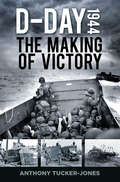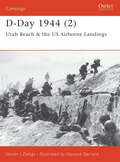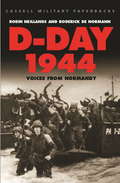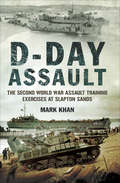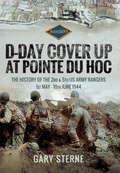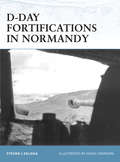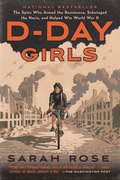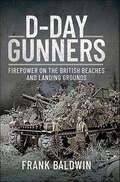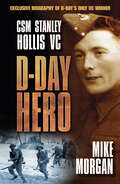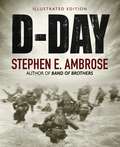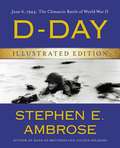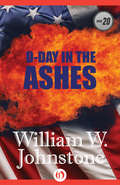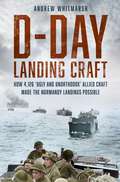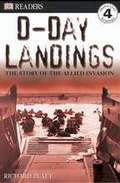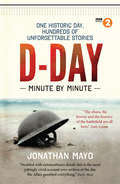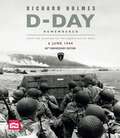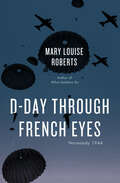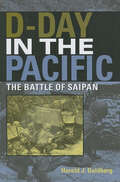- Table View
- List View
D-Day 1944: The Making of Victory
by Anthony Tucker-JonesD-Day was unprecedented. An invasion of this scale and magnitude had never been carried out before. The landings in North Africa, Sicily and Italy were of limited scope by comparison; if they had failed it would not have been a complete disaster, whereas Normandy heralded the long-awaited Second Front.D-Day 1944: The Making of Victory investigates the great feats of unique problem-solving that enabled the success of such an important invasion. Military historian Anthony Tucker-Jones brings his expert eye to bear on the D-Day landings and subsequent Normandy campaign. He reassesses the technical ingenuity required through the eyes of those who fought there, and vividly reveals how each side managed, whether dealing with the challenges of crossing the Channel safely or in defence of the French coast. Including first-hand accounts, this book places the reader in the thick of the action.
D-Day 1944: Utah Beach & the US Airborne Landings
by Steven Zaloga Howard GerrardThe second title in Osprey's survey of the D-Day landings of World War II (1939-1945). On their western flank, the Allied landings on D-Day combined a parachute drop by the 82nd and 101st Airborne Divisions with an amphibious assault on "Utah" Beach by the US 4th Infantry Division. The landings came ashore in the wrong place but met weaker German resistance as a result. The heaviest fighting took place inland where the badly scattered paratroopers gradually gathered in small groups and made for their objectives. This book traces the story of D-Day on Utah beach, revealing how the infantry pushed inland and linked up with the Airborne troops in a beachhead five miles deep. Now the battle to break out and seize the key port of Cherbourg could begin.
D-Day 1944: Voices from Normandy
by Robin Neillands Roderick De NormannThe story of D-Day, told in the words of those who were actually there.'The gigantic scale of the invasion is stunningly evoked' - MAIL ON SUNDAYAt fifteen minutes after midnight on June 6 1944, Operation 'Overlord', the Allied invasion of Hitler's Fortress Europe, became reality. In this penetrating account of D-Day and the period which followed, Robin Neillands and Roderick de Normann weave objective narration with personal accounts from those who were there to create a matchless history of the largest amphibious assault ever launched.
D-Day 1944: Voices from Normandy
by Robin Neillands Roderick De NormannThe story of D-Day, told in the words of those who were actually there.'The gigantic scale of the invasion is stunningly evoked' - MAIL ON SUNDAYAt fifteen minutes after midnight on June 6 1944, Operation 'Overlord', the Allied invasion of Hitler's Fortress Europe, became reality. In this penetrating account of D-Day and the period which followed, Robin Neillands and Roderick de Normann weave objective narration with personal accounts from those who were there to create a matchless history of the largest amphibious assault ever launched.
D-Day Assault: The Second World War Assault Training Exercises at Slapton Sands
by Mark Khan&“This superb account describes the exercises undertaken on Slapton Sands, backed up by first hand accounts from those who were there at the time.&” —Military Machines International Preceded by a massive airborne assault, the largest amphibious operation ever undertaken began on June 6, 1944—D-Day. Over a fifty-mile stretch of heavily fortified French coastline, 160,000 Allied troops came ashore on the beaches of Normandy. Supported by more than 5,000 ships and 13,000 aircraft, they quickly gained a foothold in fortress Europe. To plan and execute such a massive military operation successfully required training—and beaches. The perfect place for the Americans was found in the sleepy South Hams area of South Devon. But this choice came at a price. Over 20,000 acres of prime agricultural land, along with villages and farms were requisitioned. The peace of the South Devon coast was soon shattered as the Slapton Sands Assault Training Centre came into being. The training, however, was not without risk. During one of the final major coordinated practices—Exercise Tiger—over 800 men were lost to enemy action whilst traveling by sea to land on the beaches at Slapton Sands. Often shrouded in intrigue, this disaster has been the subject of conspiracy theories for many years. &“Using the latest information available about this secretive event, [D-Day Assault] features all aspects of the military exercises and first hand accounts of those who lived and trained there.&” —Western Morning News
D-Day Cover Up at Pointe du Hoc: The History of the 2nd & 5th US Army Rangers, 1st May–10th June 1944
by Gary SterneA follow-up to the New York Times-bestselling The Cover-Up at Omaha Beach. &“The second volume of the epic study breaks new ground.&” —Firetrench Gary Sterne, a keen collector of militaria and co-founder of The Armourer and Skirmish magazines, has always been fascinated by the D-Day landings. In particular he was intrigued by the lack of precise information relating to the mystery of the &“missing guns&” of Pointe du Hoc. His research led to the finding of a map which indicated the position of an &“unknown&” German gun position buried in the village of Maisy. The rediscovery of the Maisy Batteries made headline news around the world and his bestselling book The Cover-Up at Omaha Beach subsequently changed the history of the Omaha sector and made many start to question the Rangers&’ Pointe du Hoc mission. The Maisy site is now one of the major Normandy D-Day attractions. For the first time ever this follow-up book now offers complete Rangers history for the seven months prior to D-Day and does so using period documents, many of which have only recently been released from TOP SECRET status in U.S. Archives. The author fills in the gaps that many have only guessed at concerning the Rangers&’ real missions on D-Day, he explains why a battalion commander was removed hours before the landings, why the Rangers were not briefed on their actual D-Day missions and the extraordinary role that Lt. Col. Rudder played at Pointe du Hoc. This book is a historical game-changer that pulls no punches.
D-Day Encyclopedia: Everything You Want to Know About the Normandy Invasion (World War II Collection)
by Barrett TillmanThis unique encyclopedia provides detailed entries for everything you ever wanted to know about D-Day, the invasion of Normandy. Organized alphabetically, the entries give detailed descriptions of weapons, equipment, divisions, air and naval units, geography, terminology, personalities, and more. Every Allied division that crossed the English Channel on June 6, 1944 has its own listing as do the major Axis divisions that fought them. <P><P>Brief biographies of major military and political leaders on both sides provide a handy who's who of the campaign. The book also includes entries for related popular culture: GI slang, the best movies about D-Day, and major writers such as Stephen Ambrose and Cornelius Ryan. Cross-references make the book easy to use. With hundreds of entries, The D-Day Encyclopedia is an indispensable reference tool for history buffs and great browsing for readers who want to know more about World War II.
D-Day Fortifications in Normandy
by Hugh Johnson Steven ZalogaGerman defenses along the Normandy beaches were part of the larger Atlantic Wall fortifications designed to defend Fortress Europe. When Field Marshal Erwin Rommel took command of the invasion front in late 1943, he began a program to enhance fortifications along the Normandy coast as he believed that any Allied assault had to be stopped on the invasion beaches themselves. His most important contribution to the defenses was an extensive program of improvised beach obstructions to complicate any landing attempt. This book analyses these fortifications and describes how the Allied forces overcame them on the morning of June 6, 1944.
D-Day Girls: The Spies Who Armed the Resistance, Sabotaged the Nazis, and Helped Win World War II
by Sarah RoseThe dramatic, untold true story of the extraordinary women recruited by Britain’s elite spy agency to help pave the way for Allied victory in World War II“ <P><P>In 1942, the Allies were losing, Germany seemed unstoppable, and every able man in England was on the front lines. To “set Europe ablaze,” in the words of Winston Churchill, the Special Operations Executive (SOE) was forced to do something unprecedented: recruit women as spies. Thirty-nine answered the call, leaving their lives and families to become saboteurs in France. <P><P>In D-Day Girls, Sarah Rose draws on recently declassified files, diaries, and oral histories to tell the thrilling story of three of these remarkable women. <P><P>There’s Andrée Borrel, a scrappy and streetwise Parisian who blew up power lines with the Gestapo hot on her heels; Odette Sansom, an unhappily married suburban mother who saw the SOE as her ticket out of domestic life and into a meaningful adventure; and Lise de Baissac, a fiercely independent member of French colonial high society and the SOE’s unflappable “queen.” <P><P>Together, they destroyed train lines, ambushed Nazis, plotted prison breaks, and gathered crucial intelligence—laying the groundwork for the D-Day invasion that proved to be the turning point in the war. <P><P>Rigorously researched and written with razor-sharp wit, D-Day Girls is an inspiring story for our own moment of resistance: a reminder of what courage—and the energy of politically animated women—can accomplish when the stakes seem incalculably high.
D-Day Gunners: Firepower on the British Beaches and Landing Grounds
by Frank BaldwinPart history book and part travel guide, D-Day Gunners is aimed at anyone interested in the artillery on the D-Day beaches and landing grounds. While the heritage of the D-Day beaches and landing sites is well documented, this rarely includes the artillery story. The author of this book aims to correct this by providing a visitors' guide to the artillery stories associated with the battlefield heritage that remains on the D-Day beaches, mapping the fire-plan for D-Day against the known German locations, and looking at what happened at these places. There is relatively little explanation about the role of the artillery in general or the deeds of artillerymen, in particular those of the Royal Regiment of Artillery. This book tells of the significance of artillery on D-Day and the part it played in the outcome. Initial reports published stressed that the coastal defences were effectively neutralized by the bombing and that no significant counter attacks developed on D-Day. However, post-war accounts increasingly attributed allied success to allied fire power. The book tells the story of the men who served the guns on the D-Day beaches, and the effects they had on the outcome of the battles on D-Day and afterwards. This volume is primarily about British Gunners and certain German Kannoniers. The book has been written as a guide to the battlefields on the D-Day beaches and landing grounds, telling the gunners’ stories that are not always commemorated on memorials, interpretation boards, or recorded in more general guides. These poignant stories include war poets and heroes decorated for bravery, or just the tales of some of the men buried in the war cemeteries or commemorated on the memorials. It also provides a guide in lay terms of the technical impact of field anti-tank and AA artillery on the war. A second volume will tell the story of artillerymen on the American beaches and landing grounds.
D-Day Hero: CMS Stanley Hollis VC
by Mike MorganStanley Hollis won the Victoria Cross when, on the 6th of June 1944, he single-handedly stormed a German pillbox before going on to save the lives of two comrades.D-Day's only Victoria Cross winner, Hollis was uniquely recommended for this coveted award twice on 6 June. A tough, working-class rebel, Hollis was no model soldier: he was forever being 'busted' to corporal for various misdeameanours, only to win his stripes back again.Few soldiers can have seen as much close combat action as Stanley Hollis. He fought with the Green Howards at Dunkirk, in the Western Desert, in Italy, on D-Day and through France and Germany to the end of the war. Seriously wounded and taken prisoner by the Afrika Korps, Hollis was personally congratulated by Rommel, then made a daring escape.In Italy, he was recommended for the Distinguished Conduct Medal and was later mentioned in despatches, going on to undertake a dangerous undercover reconnaissance of the Normandy invasion beaches. On 6 June 1944 Stanley Hollis was involved in two actions that led to his award. During the primary assault, Hollis single-handedly stormed a German pillbox, saving his company from certain injury and death and enabling them to open the main beach exit. Later that day he saved the lives of two comrades trapped by heavy gunfire in a collapsing house.Fully illustrated with archive photographs and ephemera, this unique biography of a little-known British Second World War hero shows the real man behind the heroic image. Mike Morgan has received the Hollis family's full co-operation and draws exclusively on personal diaries, letters and other memorabilia.
D-Day Illustrated Edition
by Stephen E. AmbroseOn the basis of 1,400 oral histories from the men who were there, bestselling author and World War II historian Stephen E. Ambrose reveals for the first time anywhere that the intricate plan for the invasion of France in June 1944 had to be abandoned before the first shot was fired. The true story of D-Day, as Ambrose relates it, is about the citizen soldiers - junior officers and enlisted men - taking the initiative to act on their own to break through Hitler's Atlantic Wall when they realised that nothing was as they had been told it would be.D-DAY is the brilliant, no holds barred, telling of the battles of Omaha and Utah beaches. Ambrose relives the epic victory of democracy on the most important day of the twentieth century.
D-Day Illustrated Edition: June 6, 1944: The Climactic Battle of World War II
by Stephen E. AmbroseNow illustrated with an extraordinary collection of over 125 photos, Stephen E. Ambrose's D-Day is the definitive history of World War II's most pivotal battle, June 6, 1944, the day that changed the course of history.D-Day is the epic story of men at the most demanding moment of their lives, when the horrors, complexities, and triumphs of life are laid bare. Distinguished historian Stephen E. Ambrose portrays the faces of courage and heroism, fear and determination--what Eisenhower called "the fury of an aroused democracy"--that shaped the victory of the citizen soldiers whom Hitler had disparaged.Drawing on more than 1,400 interviews with American, British, Canadian, French, and German veterans, Ambrose reveals how the original plans for the invasion had to be abandoned, and how enlisted men and junior officers acted on their own initiative when they realized that nothing was as they were told it would be.The action begins at midnight, June 5/6, when the first British and American airborne troops jumped into France. It ends at midnight, June 6/7. Focusing on those pivotal twenty-four hours, the book moves from the level of Supreme Commander to that of a French child, from General Omar Bradley to an American paratrooper, from Field Marshal Montgomery to a German sergeant. Ambrose's D-Day is the most honored account of one of our history's most important days.
D-Day In the Ashes (Ashes #20)
by William W. JohnstoneFirst the Liberals took all the guns. Then they took away the people's freedom. Now, Ben Raines and his patriot army are driving a weakened United States government into full-fledged retreat. Emerging as an unstoppable force, the Southern States are winning over one strategic ally after another, from the states in the American Northwest to the Canadian provinces-all wanting to be a part of a society based on law, justice, and old-fashioned values enforced by the barrel of a gun. But to be recognized by the world community, the Southern States of America must pay a price. The U.N. wants Ben Raines's warriors to play cops in a world overrun by criminals, gangs, and cannibalistic punks. Now, Raines and his army must engage in an all-out war of liberation across a crime-ravaged Europe, one bloody mile at a time...
D-Day Landing Craft: How 4,126 ‘Ugly and Unorthodox’ Allied Craft made the Normandy Landings Possible
by Andrew WhitmarshThe contribution of landing craft and their crews to the 1944 Normandy campaign was enormous, and often overlooked. Most of the more than 132,000 Allied troops who landed on the beaches on D-Day came ashore from landing craft. The book examines why so many different types of landing craft were used in the operation; how they were built in both the UK and North America, over several years and with many competing war production requirements and operational needs. In the lead up to D-Day the Allies never seemed to have enough landing craft, their availability and production regularly discussed by top Allied leaders. This account is essential to anyone who wants to fully understand the course of D-Day, and the nature of Allied preparations for the campaign.
D-Day Landings: The Story of the Allied Invasion
by Karen Wallace Richard PlattHow did the Allies plan and execute the most massive and daring invasion in military history? Read all about it in the DK Reader that explains in thrilling detail how the Nazis were defeated on the beaches of France. DK Readers is a multi-level learning-to-read program combining DK's highly visual style with appealing stories at five graduated levels. Stunning photographs and engaging, age-appropriate stories are guaranteed to capture a child's interest while developing reading skills and general knowledge. DK Readers allow progression of stories for beginning readers with simple sentences and word repetition through to stories with rich vocabulary and more challenging sentence structure for proficient readers.
D-Day Minute By Minute: One historic day, hundreds of unforgettable stories (Minute By Minute)
by Jonathan MayoThe invasion has begun. In this gripping book, Jonathan Mayo gives a blow by blow account of the events of D-Day, revealing what happened to the people swept up in this crucial moment in history. From soldiers, French villagers and journalists, to schoolchildren and nurses, thousands were placed in extraordinary situations when the Allies landed in Normandy. This is their story.
D-Day Normandy Landing Beaches: Sixth Edition with Latitude and Longitude References (Major & Mrs Holt's Definitive Battlefield Guide)
by Tonie Holt Valmai HoltAn extensive traveler&’s guide to the French region&’s World War II historical sites and everything else you need to know about the area. Already the best-selling English-language guide to the area, universally known as &“the Bible,&” this is the sixth, completely revised, up-to-date, much expanded edition of the Definitive Guide to the D-Day Normandy Landing Beaches. The third in the Holts&’ important series of Battlefield Guides (following the Somme and the Ypres Salient), it employs the same, highly acclaimed formula. Once again, the cold facts are interlaced with anecdotes of bravery, humor, sadness, and humanity. This new edition now contains all the landing beaches: Juno, Sword, Gold, Omaha, Utah; all the airborne operations: British and American two approach routes; six timed and measured itineraries; 21 in-text itinerary maps, battle maps & diagrams; and approximately 400 recommended sites within the D-Day planned area of advance, all with photos, each with latitude & longitude references (New for this Edition). It features over 400 colored pictures and 352 pages of memorials, museums, batteries, bunkers, landing fields, historical background to the landings, the plans and what actually happened, information about Allied and German war graves, veterans&’ associations, and other commemorative associations. It also has Normandy tourist information about where to stay and to eat, and information about historical figures such as recipients of the Victoria Cross and the Medal of Honor, poets, photographers, and more.
D-Day Plus One: Shot Down and on the Run in France
by Frank Holland Adam WilkinsA World War II RAF veteran tells the dramatic story of D-Day, his survival after being shot down by the Germans, and his journey back to Allied lines. The day after D-Day, the most momentous day of the Second World War, Frank Holland was an RAF pilot whose Typhoon aircraft had just been hit by German antiaircraft fire during a low flying attack on a marshaling yard in Normandy. He managed to take the aircraft up to 1200 feet but then the engine went dead and his Typhoon soon began heading towards the earth at an accelerating and frightening speed. Struggling frantically, he just barely got free of the cockpit and baled out four or five seconds before the crash. His parachute didn&’t open but he fell into a wood, crashing through the branches of an oak to dangle precariously fifteen feet up. Breathing hard, he experienced a few seconds of relief at survival. But then he realized German troops would be swarming around within minutes. He had to get away, and fast . . . So begins Frank&’s tremendous adventure as he evaded capture for months, sometimes by barely a whisker, to make it back home to the city of his birth, Cambridge. A riveting true story told in a masterly fashion.
D-Day Remembered: From the Invasion to the Liberation of Paris
by Richard Holmes Imperial War Museum80th ANNIVERSARY EDITIONProduced in collaboration with Imperial War MuseumsRelive the day that changed the course of history. On 6 June 1944, D-Day marked the beginning of a campaign that involved more than a million men and helped seal the fate of Hitler's Germany.Written by esteemed military historian Richard Holmes and including rare documents, diaries and secret memos from the archives of the Imperial War Museums, D-Day Remembered details the planning, execution and aftermath of the most momentous event of the Second World War.
D-Day Remembered: From the Invasion to the Liberation of Paris
by Richard Holmes Imperial War Museum80th ANNIVERSARY EDITIONProduced in collaboration with Imperial War MuseumsRelive the day that changed the course of history. On 6 June 1944, D-Day marked the beginning of a campaign that involved more than a million men and helped seal the fate of Hitler's Germany.Written by esteemed military historian Richard Holmes and including rare documents, diaries and secret memos from the archives of the Imperial War Museums, D-Day Remembered details the planning, execution and aftermath of the most momentous event of the Second World War.
D-Day Through French Eyes: Normandy 1944
by Mary Louise Roberts&“A moving examination of how French civilians experienced the fighting&” at Normandy during WWII from the acclaimed author of What Soldiers Do (Telegraph, UK). &“Like big black umbrellas, they rain down on the fields across the way, and then disappear behind the black line of the hedges.&” Silent parachutes dotting the night sky—that&’s how one Normandy woman learned that the D-Day invasion was under way in June of 1944. Though they yearned for liberation, the French had to steel themselves for war, knowing that their homes, lands, and fellow citizens would have to bear the brunt of the attack. With D-Day through French Eyes, Mary Louise Roberts turns the conventional narrative of D-Day on its head, taking readers across the Channel to view the invasion anew. Roberts builds her history from an impressive range of gripping first-person accounts by French citizens throughout the region. A farm family notices that cabbage is missing from their garden—then discovers that the guilty culprits are American paratroopers hiding in the cowshed. Fishermen rescue pilots from the wreck of their B-17, then search for clothes big enough to disguise them as civilians. A young man learns to determine whether a bomb is whistling overhead or silently plummeting toward them. When the allied infantry arrived, French citizens guided them to hidden paths and little-known bridges, giving them crucial advantages over the German occupiers. As she did in her acclaimed account of GIs in postwar France, What Soldiers Do, Roberts here sheds vital new light on a story we thought we knew. "In the great tradition of Studs Terkel and Is Paris Burning?, Mary Louise Roberts uses the diaries and memoirs of French civilians to narrate a history of the French at D-Day that has for too long been occluded by the mythology of the allied landing.&”—Alice Kaplan, author of Dreaming in French
D-Day To Berlin
by Andrew WilliamsNightfall, 6 June 1944. D-Day is over and the Allies have carved a tenuous foothold in 'Fortress Europe'. The future of Europe hangs in the balance as Hitler's formidable SS Panzer troops threaten to drive them back into the sea. D-Day to Berlin is the remarkable story of the Allied struggle for survival - the battle from the beaches of Normandy to the heart of Hitler's Reich and ultimate victory just eleven months later. The campaign to free Europe from Nazi oppression through the collective operations from D-Day to Berlin mark one of the greatest ever military offensives. The Allies overcame initial setbacks to inflict a devastating defeat on Hitler's crack divisions in France - a victory that was threatened just months later in the bitter winter fighting of the Battle of the Bulge. The final crossing of the Rhine and the advance into Germany changed the course of European history forever. In D-Day to Berlin we meet men and women from both sides - British, American and German soldiers - whose bravery and endurance made the final push through Europe the defining drama of the Second World War.
D-Day To Berlin
by Andrew WilliamsNightfall, 6 June 1944. D-Day is over and the Allies have carved a tenuous foothold in 'Fortress Europe'. The future of Europe hangs in the balance as Hitler's formidable SS Panzer troops threaten to drive them back into the sea. D-Day to Berlin is the remarkable story of the Allied struggle for survival - the battle from the beaches of Normandy to the heart of Hitler's Reich and ultimate victory just eleven months later. The campaign to free Europe from Nazi oppression through the collective operations from D-Day to Berlin mark one of the greatest ever military offensives. The Allies overcame initial setbacks to inflict a devastating defeat on Hitler's crack divisions in France - a victory that was threatened just months later in the bitter winter fighting of the Battle of the Bulge. The final crossing of the Rhine and the advance into Germany changed the course of European history forever. In D-Day to Berlin we meet men and women from both sides - British, American and German soldiers - whose bravery and endurance made the final push through Europe the defining drama of the Second World War.
D-Day in the Pacific: The Battle of Saipan (Twentieth-Century Battles)
by Harold J. Goldberg“The narrative moves smoothly and crisply. There is effective treatment of strategy, preparations, and then the invasion and battle for Saipan itself.” —Spencer C. Tucker, author of American RevolutionIn June 1944 the attention of the nation was riveted on events unfolding in France. But in the Pacific, the Battle of Saipan was of extreme strategic importance. This is a gripping account of one of the most dramatic engagements of World War II. The conquest of Saipan and the neighboring island of Tinian was a turning point in the war in the Pacific as it made the American victory against Japan inevitable. Until this battle, the Japanese continued to believe that success in the war remained possible. While Japan had suffered serious setbacks as early as the Battle of Midway in 1942, Saipan was part of her inner defense line, so victory was essential. The American victory at Saipan forced Japan to begin considering the reality of defeat. For the Americans, the capture of Saipan meant secure air bases for the new B-29s that were now within striking distance of all Japanese cities, including Tokyo.“Harold Goldberg’s riveting story of this conflict brings the dead back to life by blending rigorous research with dramatic narratives by hundreds of survivors. He has written a superb account of a pivotal, little-known, and heart-breaking battle.” —Col. Joseph H. Alexander, USMC (ret.),author of Storm Landings“Using recent interviews he conducted with extant US veterans, [Goldberg] skillfully develops the soldiers’ view of the battle for Saipan in an engaging, clearly written and interesting volume.” —The Journal of Military History
